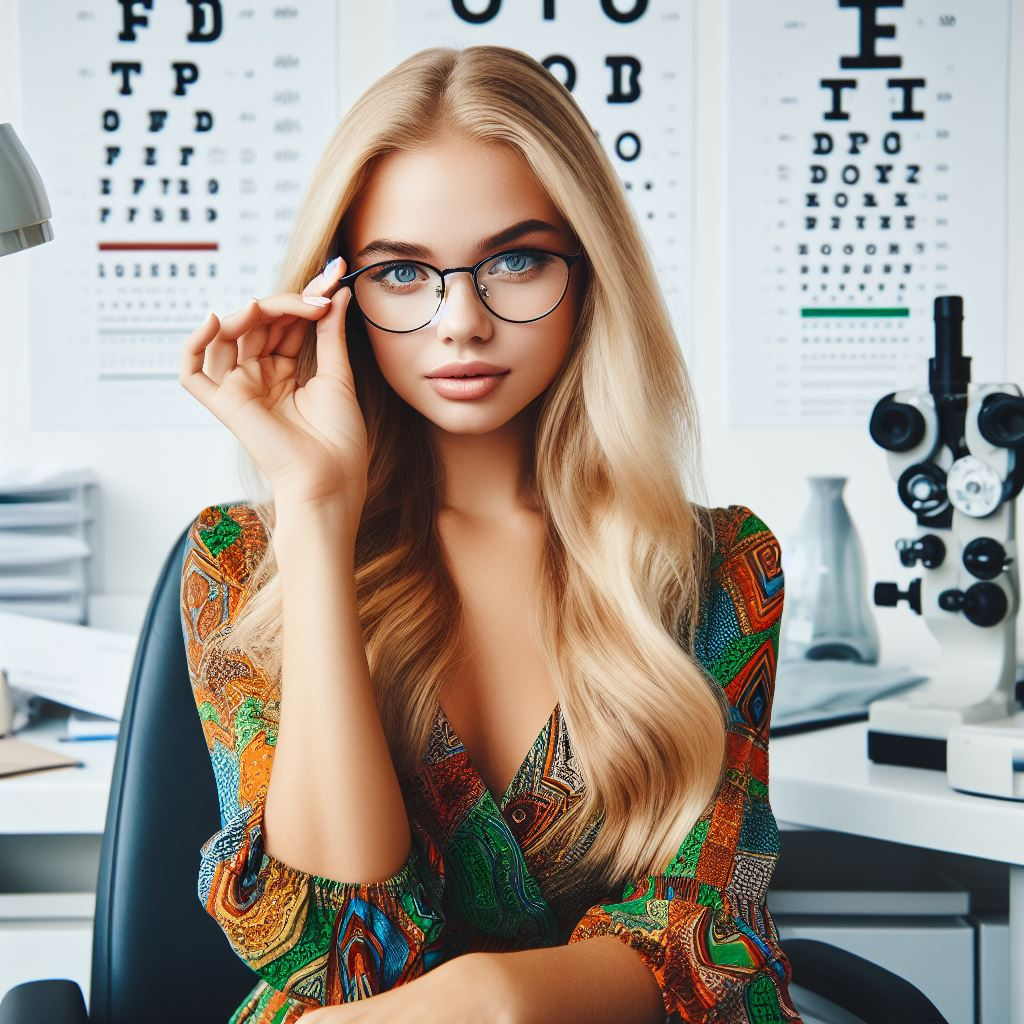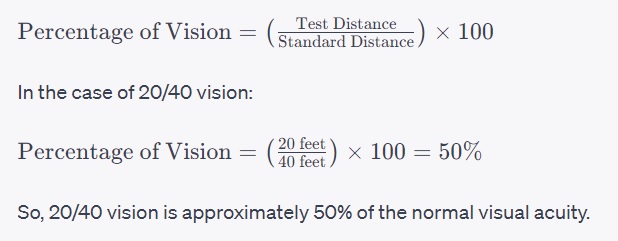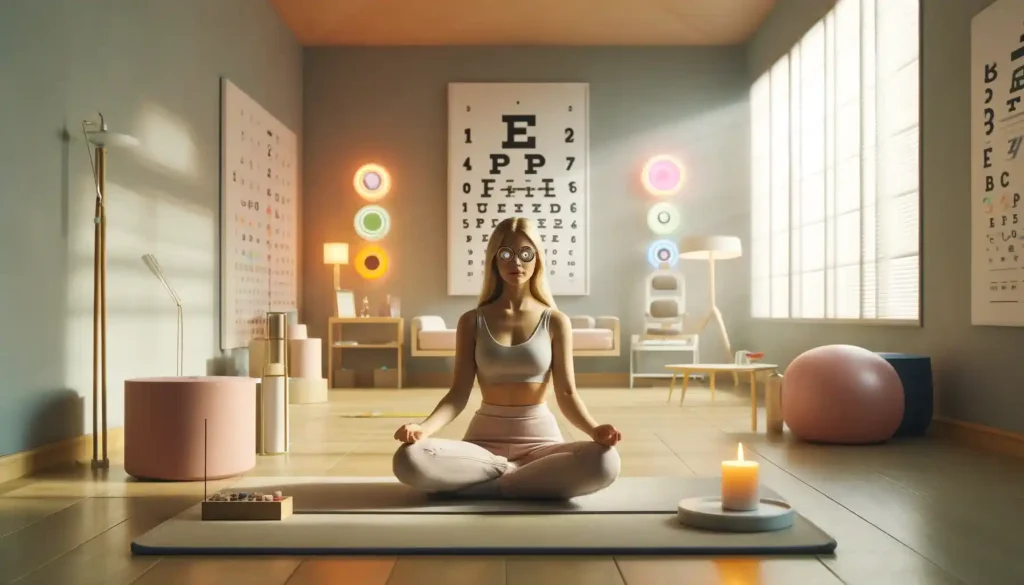What You Need to Know About Mild Visual Impairment. Vision is a fundamental sense that significantly influences our daily experiences. Our ability to see clearly affects how we perceive the world, engage with others, and navigate various environments. Visual acuity, often measured using standards like 20/20, defines the sharpness of our vision. However, not everyone possesses this perfect vision. Some individuals have 20/40 vision, indicating a mild visual impairment that impacts their daily lives in specific ways. In this comprehensive guide, we will delve into the intricacies of 20/40 vision, exploring its definition, causes, symptoms, implications, diagnosis, coping strategies, and more.

Understanding What is 20/40 Vision: Definition and Measurement
20/40 vision means that a person can see at 20 feet what a person with normal vision can see at 40 feet. To convert this measurement to a percentage, you can use the following formula:

Percentage of Vision=(Standard Distance : Test Distance)×100
In the case of 20/40 vision:
Percentage of Vision=(40 feet : 20 feet)×100=50%
So, 20/40 vision is approximately 50% of the normal visual acuity.
Causes of 20/40 Eyesight: Exploring Refractive Errors
The primary cause of 20/40 vision is refractive errors, such as myopia (nearsightedness), hyperopia (farsightedness), and astigmatism. These errors arise when the shape of the eye hinders light from accurately focusing on the retina. In myopia, distant objects appear blurry, while hyperopia affects close-up vision. Astigmatism, on the other hand, causes blurred or distorted vision at various distances.
Symptoms and Signs of 20/40 Vision: Recognizing Visual Challenges
Individuals with 20/40 vision often experience symptoms such as blurry vision, difficulty reading small text, and challenges in low-light conditions. Activities like reading, driving, and recognizing faces may become cumbersome. These symptoms can significantly impact daily tasks, requiring specific adaptations and interventions.
Implications of 20/40 Sight: Challenges in Daily Life
The implications of the 20/40 vision extend to various aspects of daily life. Reading becomes more challenging, especially with smaller fonts or texts in low-light environments. Driving may require additional caution, and recognizing faces from a distance can be difficult. These challenges can affect confidence and overall quality of life, necessitating coping strategies and assistive measures. You can start eye training to improve your eye health.
Diagnosis and Eye Examinations: Seeking Professional Help
Diagnosing 20/40 Eyesight requires a comprehensive eye examination conducted by an optometrist or ophthalmologist. Regular eye check-ups are vital for early detection and management. During these examinations, various tests, including visual acuity tests, refraction tests, and eye health evaluations, help specialists determine the degree of visual impairment and prescribe appropriate corrective measures.
20/40 Vision in Everyday Life: An In-Depth Analysis

Vision acuity measurements are a fundamental aspect of eye health, offering insights into one’s ability to discern objects at various distances. A common standard for measuring visual acuity is the Snellen chart, which compares an individual’s eyesight to what is considered normal or 20/20 vision. While 20/40 vision is below the optimal 20/20 standard, it’s crucial to understand its implications in daily activities and when it necessitates correction.
Daily Life with 20/40 Sight
For individuals with 20/40 vision, the world is slightly less sharp than for those with 20/20 vision, but this does not mean they are significantly hindered in their daily activities. Here’s how 20/40 vision can impact various aspects of everyday life:

- Driving: In many jurisdictions, 20/40 vision is the minimum requirement for driving without corrective lenses. This standard ensures that drivers can read road signs, see obstacles, and respond to conditions adequately. However, in dim lighting or adverse weather conditions, individuals with 20/40 vision may find it more challenging to navigate.
- Reading and Screen Time: Those with 20/40 vision might experience difficulty when reading fine print or engaging with digital screens for prolonged periods. This can lead to eye strain or fatigue, especially in poor lighting conditions or when dealing with high-resolution screens.
- Outdoor Activities: In outdoor settings, people with 20/40 vision may not notice a significant impact during day-to-day activities like walking, jogging, or casual sports. However, for activities requiring acute visual precision, such as golf or archery, this level of vision might not be optimal.
- Professional Implications: Certain professions with stringent visual acuity requirements, such as pilots, surgeons, or graphic designers, may require correction of 20/40 vision to ensure performance and safety.
Managing 20/40 Sight
For many, 20/40 vision does not dramatically impede daily life, and some may not even realize their vision isn’t at the 20/20 standard. However, for those who experience discomfort or limitations, several corrective measures can be considered:
Lifestyle Adjustments: Adjusting screen brightness, increasing text size, and ensuring adequate lighting can mitigate some challenges associated with 20/40 vision, reducing eye strain and improving clarity.
Living with a 20/40 vision is a reality for many people. While it is below the ideal 20/20 standard, individuals with 20/40 vision can lead full and active lives with minimal adjustments or corrective measures. Recognizing and addressing any limitations ensures that this level of visual acuity does not hinder one’s quality of life or professional achievements. Regular eye exercises are crucial for improving vision health and making informed decisions about the need for correction or other interventions

Unlock Your Clearer Vision at Eyesight Academy: Your Gateway to Natural Vision Improvement!
Are you tired of 20/40 vision? Say goodbye to blurry vision and hello to a brighter, clearer world with Eyesight Academy’s revolutionary course in Natural Vision Improvement!
👁️ Why Choose Eyesight Academy? At Eyesight Academy, we believe in the power of natural techniques to enhance your vision. Our comprehensive course is designed to empower you with practical, holistic methods that promote eye health and restore your natural eyesight. Say farewell to strained eyes and hello to vibrant, crystal-clear vision naturally!
🔍 What You’ll Learn?
Holistic Vision Exercises: Discover proven exercises tailored to strengthen your eye muscles and improve focus. Nutrition for Healthy Eyes: Learn the secrets of a vision-friendly diet that nourishes your eyes from within.
Stress Reduction Techniques: Unwind with relaxation practices that alleviate eye strain and enhance visual clarity. Lifestyle Adjustments: Explore everyday habits that protect your eyes from digital strain and environmental stressors.
Ready to embrace a future with a clear, natural vision? Don’t miss this opportunity! Enroll now at Eyesight Academy and embark on your journey to visual freedom. Invest in your eyesight today, and see the world in all its vibrant, crisp glory!
See Clearly, Live Fully with Eyesight Academy!

Living with 20/40 Eyes: Coping Strategies and Adaptations
Living with a 20/40 requires adaptive strategies to overcome daily challenges. Improved lighting conditions, especially while reading, can enhance visibility. Magnification tools, both physical magnifiers and smartphone applications, aid in reading small texts. Organizational techniques, such as labeling items, assist in daily tasks. Building confidence and maintaining a positive attitude are essential in adapting to visual impairment.
Pediatric 20/40 Vision: Challenges in Children and Early Intervention
Detecting vision issues in children, including 20 40 vision, requires vigilance from parents and educators. Signs such as squinting, excessive eye rubbing, or difficulty seeing distant objects should not be ignored. Early intervention is crucial to prevent potential learning difficulties and ensure proper visual development. Vision therapy, involving exercises and activities to improve visual skills, is a valuable tool in managing pediatric visual impairments.
Raising Awareness and Support: Advocacy for Mild Visual Impairment
Public awareness campaigns play a significant role in educating communities about mild visual impairments like 20/40 vision. These initiatives emphasize the importance of regular eye check-ups and promote understanding and empathy for individuals with visual challenges. Support systems and organizations provide valuable resources, including counseling, educational materials, and assistive devices, fostering a supportive environment for those with mild visual impairments.
Conclusion: Embracing Differences and Enhancing Lives
In conclusion, understanding 20 40 vision is crucial for both individuals affected by mild visual impairment and the society around them. By recognizing the challenges faced by individuals with 20/40 vision, we can foster empathy, raise awareness, and create inclusive environments. Through early diagnosis, appropriate interventions, and supportive communities, individuals with 20/40 vision can lead fulfilling lives, embracing their unique perspectives and contributing meaningfully to society. As we embrace differences and enhance accessibility, we pave the way for a world where everyone, regardless of their visual acuity, can thrive and succeed.

